
Behind the Full Moonlight: A Story of Coral Reef Life Cycles
Our staff member Anasthasia reflects on her first coral spawning in Tulamben and updates from this coral spawning season in 2025.
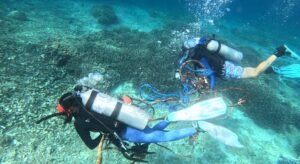
When Mooring Buoys Become a Threat to the Corals We Protect
Corals – The Hidden Foundation of Marine Life In Nusa Penida, tens of thousand of visitors visit Manta Point in Nusa Penida, Bali. But behind every manta ray, mola mola, or school of reef fish lies a hidden truth: without coral reefs, none of these creatures could survive. Coral reefs provide homes to the baby fish to hide from predators, or host the species that these iconic species feed on. Ocean Gardener has been working with the local fishermen community, Nuansa Pulau. Together, we have been planting over 200,000 corals at the Ped restoration site in

Modular, scaleable solution for sewage treatment in remote locations, the Reef Saver
While in Raja Ampat, we discovered how some communities are using a simple, modular wastewater treatment solution “Reef Saver” to minimize the impact of tourism on the local reefs.

New Acropora ID course in Banda-Neira, 16-27th December 2025
A unique experience to learn about Acropora! Ocean Gardener together with Luminocean will run their first Acropora ID course in Banda this December.
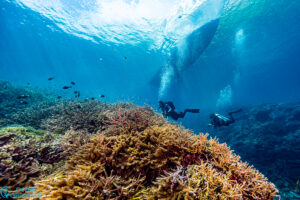
Banda Neira: Discovering a hidden paradise
Our team goes to Ambon to do a reconnaissance dive, check out the corals and ecosystem in this part of Indonesia. We share our experience in this latest blog post.
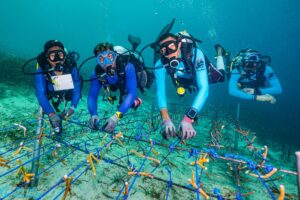
Ocean Gardener’s 4 Weeks Coral Restoration Certificate in Raja Ampat, West Papua
Jonathan takes us through our recent course done for the first time in Raja Ampat in collaboration with our partner NGOs. We live aboard Galaxea with seven scholarship recipients and learned about corals and the different methods of restoring. Follow our journey and learn about the participants in this course.

Impressive results after 2 weeks of running our Mineral Accretion Technology pilot
We revisited our first Mineral Accretion Technology (MAT) after 2 weeks to monitor its progress. You can read our previous blog post about the MAT system installation. It goes through the installation process and technical details of our pilot site in front of our partners, the MERO Foundation, in Tulamben, East Bali. It took many years to convince us to try Mineral Accretion Technology (MAT). Like many, we had been disappointed with the published results achieved by various organizations using this technique in their own projects. Nevertheless, being stubborn, we preferred to see for ourselves
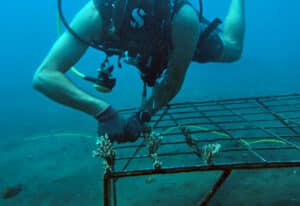
Our Mineral Accretion Technology Pilot Test
Last month, Ocean Gardener started a pilot trial for Mineral Accretion Technology (MAT) in Tulamben, East Bali, to assess its effectiveness in promoting faster and healthier coral growth compared to existing methods. We go behind the scenes for a look at how we did it and the materials we chose.
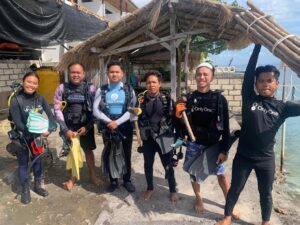
Sustaining What We’ve Planted: The Importance of Coral Reef Maintenance with Local Communities in Bali and Nusa Penida.
We know successful coral reef restoration is more than just planting fragments; it requires long-term maintenance and community involvement. In this article, we explore what that means and how we collaborate with the local community.

Will Nusa Penida Succumb to Over Tourism Like Bali?
Our new blog post examines the threat of unsustainable tourism development in Nusa Penida to the coral reefs. While the Marine Protected Area (MPA) has been established since 2010, land-based pollution from unchecked development is starting to degrade these vital ecosystems.
Our coral restoration efforts in Ped show promising progress, but the long-term health of Nusa Penida’s marine life depends on sustainable management, including clear guidelines for visitors and developers, robust waste management, and comprehensive environmental protection. Let’s protect this paradise!
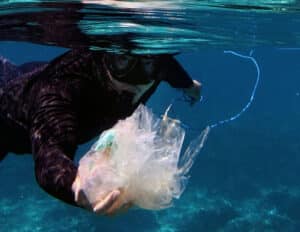
Bali’s Plastic Problem: A 2025 Update on the Fight for a Cleaner Paradise
Our latest blog post looks at the recent plastic ban in Bali. With all the plastic pollution we saw during our dives, we were curious about the recent plastic ban. Bali generates 3,436 tons of waste daily, with landfills overflowing into illegal disposal. The ban is set for full enforcement by January 2026 will span all sectors including government, businesses, and schools, is a key step towards Bali’s ambitious goal of becoming waste-free by 2027.
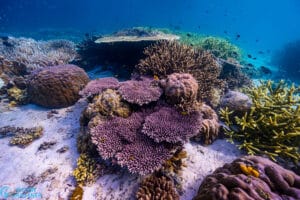
Common Coral Outplanting Methods Used In Coral Restoration
One of our founders, Vincent Chalias, shares the 7 most common outplanting methods used in coral restoration and their pros and cons.